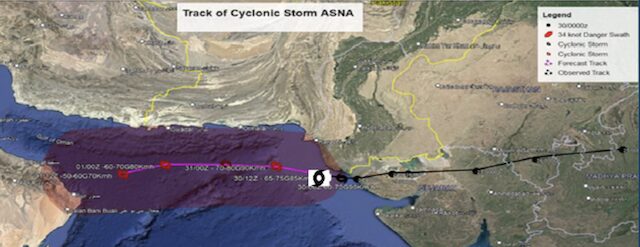North Indian Ocean: Cyclonic Storm Asna Lashes India and Pakistan
Cyclonic Storm Asna which formed in the Arabian Sea on August 24 as a severe depression was upgraded and named on August 30 as it pelted areas of north western India and Pakistan with torrential rainfall.
Published 2 weeks ago
Flooding and evacuations
The resulting flooding from Asna led to 32 deaths and the evacuation of more than 32,000 people in India’as Gujarat’s Saurashtra-Kachchh region. The intense flooding has also led to crocodiles taking over the city of Vadodara, according to India’s Meteorological Department.
In an update provided via the Joint Typhoon Warning Center (JTWC) on August 31, the cyclonic storm was located 187km southwest of the Pakistan city of Karachi and was tracking west-northwestward.
The Pakistan Meteorological Department report, “Heavy rains may create water logging in low-lying areas of Makran coast.” Sea conditions were likely to remain rough/very rough with squally winds of 60-70 km/h gusting 80km. Fishermen in the Sindh and Baluchistan regions are advised not to venture into the sea for several days.
Asna Expected to Miss Oman
The Director General of Meteorology at the Sultanate of Oman’s Civil Aviation Authority Abdullah bin Rashid Al-Khadouri, said all indicators showed that tropical cyclone Asna will deviate when it reaches the gateway to the Sea of Oman towards the south to the southwest and will not cross the coasts of the Sultanate.


Second Named Storm
Asna is the second named storm of the North Indian Ocean Cyclone season following Severe Tropical Storm Remal, which battered Bangladesh in late May 2024.
The North Indian Ocean cyclone season has no official bounds, but cyclones tend to form between April and December, with the peak from May to November. These dates conventionally delimit the period of each year when most tropical cyclones form in the northern Indian Ocean.
The area covered is the Indian Ocean east of the Horn of Africa and west of the Malay Peninsula. With the two main seas being the Arabian Sea to the west of the Indian subcontinent and the Bay of Bengal to the east.
…………………………………
Related News:
- Cyclone Asna Steers Away from Karachi – Winds, Heavy Rains Forecast for Coastal Areas (Dawn News)
- Asna to Deviate before Reaching Oman shores (Arabian Stories)
…………………………………
Related Links:
- Pakistan Meteorological Department
- India Meteorological Department
- Joint Typhoon Warning Center
- Zoom Earth – ASNA
…………………………………
Find out all news, reports, links and comments posted on Noonsite, plus cruising information from around the world, by subscribing to our FREE monthly newsletter. Go to https://www.noonsite.com/newsletter/.
Related to following destinations: Cochin (Kochi), India, Madras (Chennai), Mangalore (Mangaluru), Mina al Fahal, Mumbai (Bombay), Musandam Peninsula, Muscat, Oman, Panaji (Goa), Port Salalah (Mina Raysut)
Related to the following Cruising Resources: Hurricanes and Tropical Cyclones, Indian Ocean, Routing, Weather


